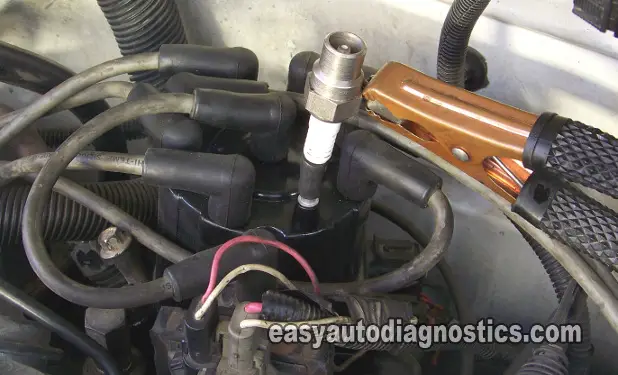TEST 1: Testing For Spark At The Spark Plug Wires

OK, if you're trying to troubleshoot a misfire and you don't know which cylinder is the one missing, then this is your starting point.
If you need to just test the ignition coil, your starting point is TEST 3: Testing The Ignition Coil's High Tension Wire.
If you need to just test the distributor's pick up coil, your starting point is TEST 7: Testing The Pick Up Coil Signal.
If you don't know where to start, start here. This whole thing is designed to test for a misfire or an engine no-start and this test (TEST 1) will get you started either way.
IMPORTANT: Just a friendly reminder that to get an accurate test result, you should NOT use a regular spark plug in place of a spark tester for the spark test.
Also, don't pull the spark plug wire off of the spark plug while the engine is cranking (to check for spark) because this will damage the ignition coil.
OK, let's start:
- 1
Remove the spark plug wire from its spark plug.
- 2
Attach the HEI spark tester (or an equivalent spark tester) to the spark plug wire (as shown in the photo above).
Don't have an HEI spark tester? Need to buy one? You can buy it here: OTC 6589 Electronic Ignition Spark Tester). - 3
Ground the HEI spark tester to the battery negative (-) terminal with a battery jump start cable (see photo above).
- 4
Have your helper crank the engine while you observe the spark tester.
- 5
The spark tester will do one of two things: spark or not spark.
- 6
Repeat the test for all of the remaining spark plug wires.
Let's take a look at what your test results mean:
CASE 1: You got spark on all of the spark plug wires. This is the correct test result and it tells you that the spark plug wires, distributor cap and rotor, ignition module, and ignition coil are working. These components are NOT the cause of your no-start condition.
If your vehicle is still suffering a misfire, go to: Other Misfire Causes for some specific testing suggestions.
CASE 2: You got NO spark from all of the spark plug wires. This result doesn't condemn any specific component just yet.
The next step is to test the spark plug wire that attaches to the middle tower of the distributor cap for spark. Go to: TEST 3: Testing The Ignition Coil's High Tension Wire.
CASE 3: You got spark on some BUT NOT all of the spark plug wires. This test result is usually due to bad spark plug wires or a bad distributor cap.
It's a common problem for one or two spark plug wires to go bad or for one or two distributor cap towers to go bad and not let spark thru'. 90% of the time replacing the distributor cap, the distributor rotor and the spark plug wires should solve your problem, BUT to further test this, go to TEST 2: Testing For Spark At The Distributor Cap.
TEST 2: Testing For Spark At The Distributor Cap

IMPORTANT: This test is only for when one or several (but not all) of the spark plug wires did not spark in TEST 1!
In this test, you'll be able to confirm that the spark plug wires that did not spark in TEST 1 are bad or not.
How? By testing for spark directly on the distributor cap towers that feed those spark plug wires.
OK, this is what you need to do:
- 1
Remove the spark plug wire that did not spark from its tower on the distributor cap.
- 2
Connect the spark tester directly on the tower.
NOTE: You'll need to use a small piece of vacuum hose to attach the HEI spark tester to the cap tower being tested. - 3
Ground the spark tester to the battery negative (-) terminal with battery jump-start cable.
The battery jump-start cable will help you hold the spark tester to the tower. - 4
Have your assistant crank the engine while you observe the spark tester.
- 5
You're gonna' get one of two results: spark or no spark.
- 6
Repeat this test with the others that did not fire off spark (if applicable).
Let's analyze your test results:
CASE 1: You got spark. This is the correct test result and it lets you know that the spark plug wire is bad, replace them all. Replacing the spark plug wires should solve your misfire problem.
Here's why: As the spark plug wire ages, its normal resistance to spark increases to the point that it can not and does not transmit the spark to the spark plug. This will either cause a misfire, or a lack of power, or a no-start condition. Spark plug wires don't last forever, especially after-market ones (average life-span is 3 to 4 years).
CASE 2: You got NO spark. Then the distributor cap is bad. Replace the distributor cap and distributor rotor as a set. This should solve your misfire problem.
Here's why: As the distributor cap ages, the terminals that transmit the spark to the spark plug wires corrode. This corrosion increases the resistance to spark and over time (as more corrosion is created) this same corrosion stops the spark from passing thru' to the spark plug wires.
